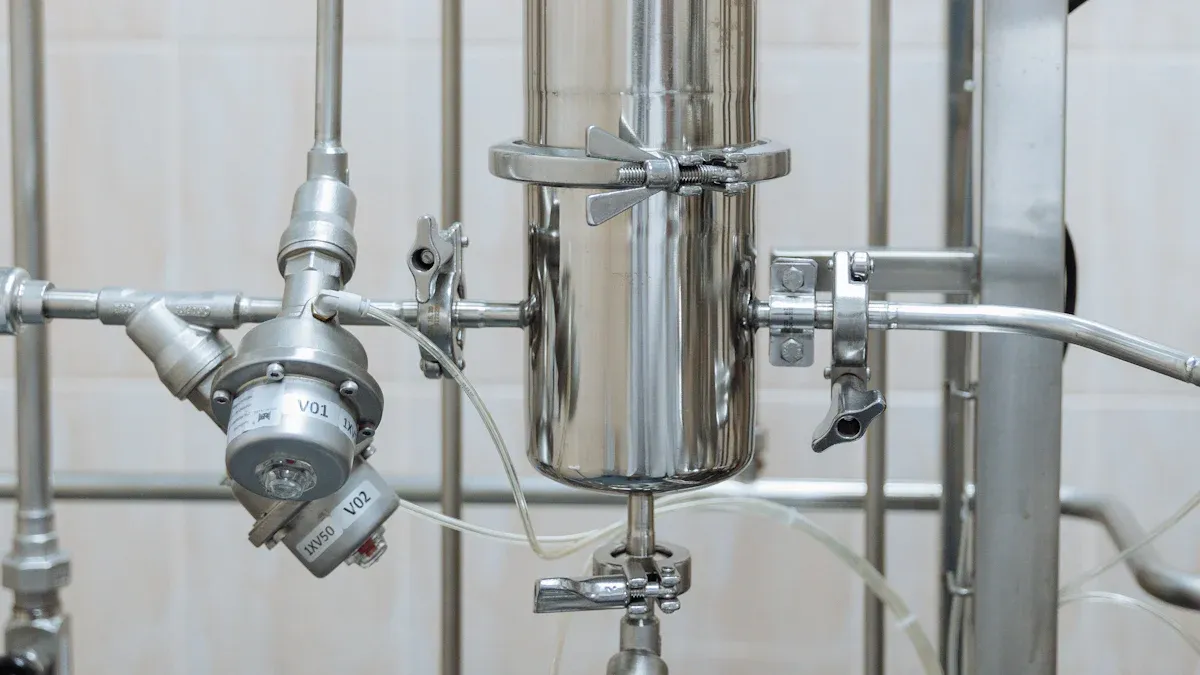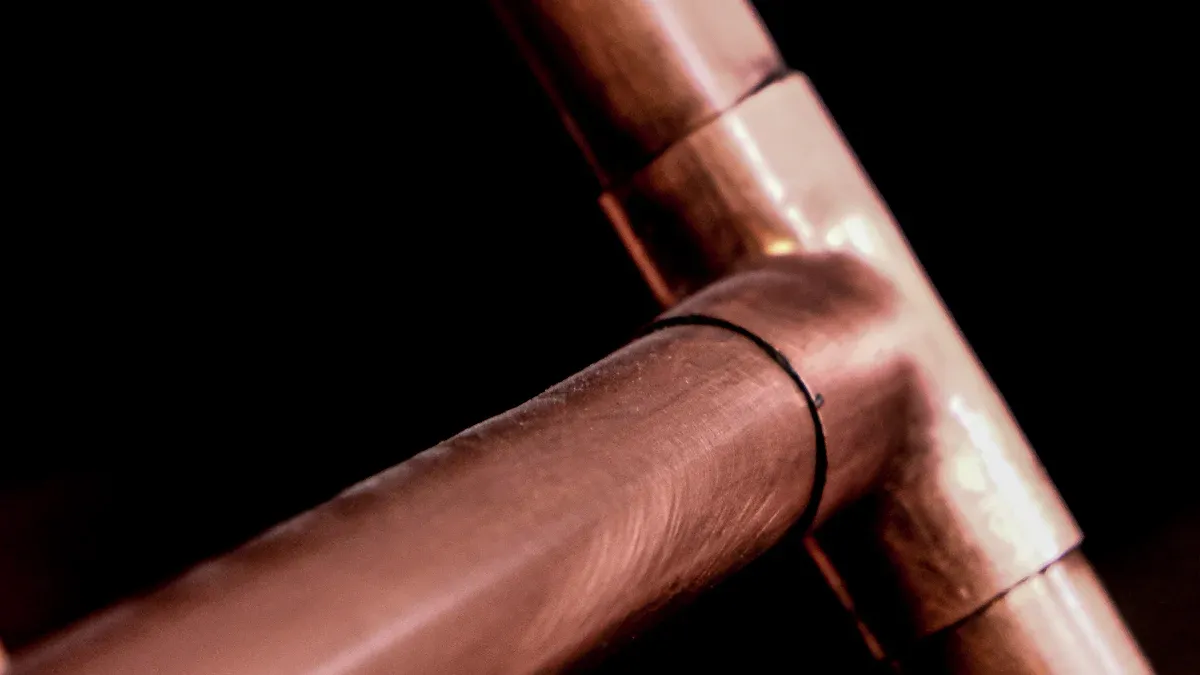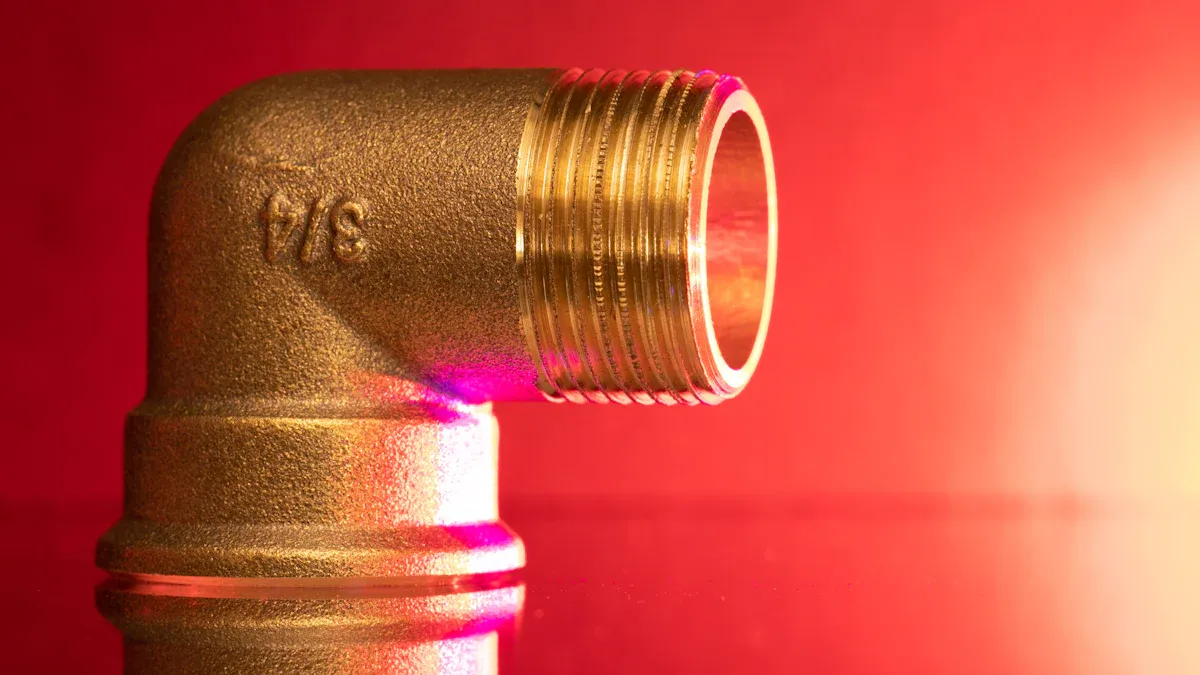
Press fittings play a vital role in creating efficient and reliable plumbing and piping systems. Selecting the wrong fittings can lead to serious issues, including leaks, system failures, and costly repairs. For example, fittings incompatible with system specifications may deform or fail to seal properly, causing leaks. Additionally, poor installation or material mismatches in PEX systems often result in widespread failures. Understanding these risks highlights the importance of choosing the right fittings for long-term performance.
Key Takeaways
- Pick press fittings that work well with the pipe material. This stops leaks and keeps the system working properly.
- Make sure the fitting size matches the pipe size exactly. The inside of the fitting should fit the outside of the pipe.
- Check for trusted certifications like ASTM F1960. These prove the fittings are high-quality and meet industry rules.
Understanding Press Fittings

Overview of Press Fittings
Press fittings have revolutionized plumbing and piping systems by offering a reliable and efficient alternative to traditional connection methods like soldering or threading. These fittings use a mechanical press to create a secure, leak-proof seal between pipes. I’ve observed that their popularity has grown due to their ease of use and ability to reduce installation time significantly.
To understand their evolution, let’s look at historical data:
| Chapter | Description |
|---|---|
| 1 | Product Definition, Product Types, Volume and Revenue analysis from 2018 to 2023. |
| 2 | Manufacturer Competition Status, including Sales and Revenue comparison, and Mergers & Acquisitions activities. |
| 3 | Historical (2018-2022) and forecast (2023-2029) volume and revenue analysis. |
| 4 | Product Application, Volume and Revenue analysis from 2018 to 2023. |
| 10 | Manufacturers’ Outline, including sales, revenue, and recent developments. |
| 11 | Industry Chain, covering raw materials and manufacturing costs. |
| 13 | QYResearch’s Conclusions based on comprehensive survey. |
This data highlights the steady growth and innovation in press fittings over the years, making them a cornerstone of modern plumbing systems.
Types of Press Fittings
Press fittings come in various types, each designed for specific applications. Common options include copper, stainless steel, and PEX press fittings. Copper fittings are ideal for potable water systems, while stainless steel offers superior corrosion resistance for industrial use. PEX fittings, on the other hand, are lightweight and flexible, making them perfect for residential plumbing.
Applications in Plumbing and Piping Systems
Press fittings are versatile and find applications in residential, commercial, and industrial systems. I’ve seen them used in water supply lines, heating systems, and even gas distribution networks. Their ability to handle high pressure and temperature makes them indispensable in critical systems.
Tip: Always choose press fittings based on the specific requirements of your system to ensure optimal performance.
Key Factors to Consider
Material Compatibility
Choosing the right material for press fittings is crucial for system performance. I always ensure the material matches the application requirements. For instance, brass and copper fittings work well in potable water systems, while stainless steel is ideal for industrial environments due to its corrosion resistance. A mismatch in material can lead to chemical reactions, weakening the connection over time.
A study on material sensitivity highlights the importance of compatibility in high-pressure systems. For example, materials tested under liquid oxygen conditions showed increased sensitivity as pressure rose. This underscores the need to select materials that can withstand the specific conditions of your system.
| Key Factor | Description |
|---|---|
| Material Selection | PEX press fittings come in brass, copper, and stainless steel, each suited for different uses. |
Tip: Always verify the material’s compatibility with the fluid and environmental conditions of your system.
Accurate Sizing and Fit
Accurate sizing ensures a secure and leak-proof connection. I’ve learned that the inner diameter (ID) of the fitting must match the outer diameter (OD) of the pipe. For example, a 20mm OD pipe requires a fitting with a 20mm ID. Using mismatched sizes can result in loose connections or damage during installation.
Common sizes for press fittings range from 15mm to 54mm for copper and stainless steel. Always measure carefully and double-check specifications before purchasing.
- Ensure the ID of the fitting matches the OD of the pipe.
- Common sizes include 3/8 inch to 1 inch for PEX tubing.
- Use a caliper or sizing tool for precise measurements.
Note: Incorrect sizing is one of the leading causes of system failures in plumbing installations.
Certifications and Standards
Certifications ensure the quality and compliance of press fittings with industry standards. I always look for fittings that meet recognized certifications like ASTM F1960 or ISO 9001:2015. These certifications guarantee that the fittings have undergone rigorous testing for safety and performance.
Some key certifications include:
- ASTM (American Society for Testing and Materials): Ensures technical standards for materials and products.
- ISO 9001:2015: Verifies consistent quality management systems.
- API Q1 10th Edition: Focuses on risk management and product reliability.
Tip: Check local building codes to ensure the fittings comply with regional requirements.
Environmental Conditions
Environmental factors like temperature, humidity, and exposure to chemicals can impact the performance of press fittings. I always assess the installation environment before selecting fittings. For example, stainless steel fittings perform better in corrosive or high-temperature environments compared to copper or brass.
Organizations like REACH and AGORA provide risk assessments to help identify environmental challenges. These studies emphasize the importance of selecting fittings that can withstand specific conditions, such as extreme temperatures or chemical exposure.
- Consider the operating temperature range of the system.
- Evaluate the potential for chemical exposure or corrosion.
- Use fittings with protective coatings for harsh environments.
Durability and Longevity
Durability is a key factor in minimizing maintenance and replacement costs. I prioritize fittings that offer resistance to corrosion, high temperatures, and mechanical stress. For example, stainless steel fittings provide excellent longevity in industrial applications, while brass fittings are more suitable for residential plumbing.
| Key Factor | Description |
|---|---|
| Long-Term Durability | Choose fittings resistant to corrosion, high temperatures, and chemicals to prevent leaks. |
Tip: Investing in durable fittings reduces the risk of system failures and ensures long-term reliability.
Cost vs. Long-Term Savings
While cost is an important consideration, I always weigh it against long-term savings. Cheaper fittings may save money upfront but could lead to higher maintenance and repair costs. High-quality press fittings, though more expensive, often provide better performance and durability, reducing overall expenses over time.
For example, stainless steel fittings may have a higher initial cost but offer superior resistance to corrosion and wear, making them a cost-effective choice for industrial systems.
Note: Consider the total cost of ownership, including installation, maintenance, and potential repairs.
Ease of Installation
Ease of installation can significantly impact project timelines and labor costs. I prefer press fittings because they eliminate the need for soldering or threading, reducing installation time. Their user-friendly design allows for quick and secure connections, even in tight spaces.
- Use proper tools like press machines for consistent results.
- Follow manufacturer guidelines to avoid installation errors.
- Ensure pipes are clean and free of debris before pressing.
Tip: Proper installation practices enhance the performance and longevity of press fittings.
Common Mistakes to Avoid

Neglecting Material Compatibility
Material compatibility is one of the most critical factors in press fitting installations. I’ve seen firsthand how ignoring this aspect can lead to disastrous outcomes. For example, pairing stainless steel press fittings with incompatible steel pipes often results in leaks and corrosion. These issues not only compromise system performance but also increase maintenance costs.
Manufacturers provide detailed specifications to guide material selection. However, many installers overlook these guidelines, leading to preventable failures.
- Ensuring compatibility between press fittings and pipe materials is essential.
- Corrosion and leaks often occur when incompatible materials are used.
- Manufacturer specifications outline which materials work best together.
Tip: Always verify material compatibility with the system’s fluid and environmental conditions to avoid costly repairs.
Incorrect Sizing or Fit
Using the wrong size press fitting is a common mistake that can jeopardize the entire system. I’ve observed cases where mismatched sizes caused loose connections, leading to leaks and inefficiencies. Proper training and attention to detail are crucial to avoid such errors.
Some common issues include:
- Insufficient training, which leads to improper sizing decisions.
- Inadequate pipe preparation, such as uneven cuts or debris, which affects the fit.
- Misapplication of fittings, where unsuitable sizes are used for specific systems.
Note: Always measure the pipe’s outer diameter and match it with the fitting’s inner diameter. Double-check specifications to ensure a secure and leak-proof connection.
Using Improper Tools
The tools used during installation play a significant role in the success of press fittings. I’ve encountered situations where improper tools caused incomplete connections or even damaged the fittings. For instance, using uncalibrated press machines often results in weak seals that fail under pressure.
| Key Findings and Recommendations | Description |
|---|---|
| Cause of Failure | Hydrogen-induced stress corrosion cracking (SCC) due to hydrogen embrittlement. |
| Coating Standards | Bolt coatings were not processed according to ASTM B633. |
| Industry Standards | Existing standards do not adequately address bolting/connector performance in subsea applications. |
| Quality Management System | Qualified only first-tier suppliers, neglecting others in the supply chain. |
| Recommendations | Develop improved quality management standards and promote failure reporting for critical safety equipment. |
Tip: Always use manufacturer-recommended tools and ensure they are properly calibrated before starting the installation process.
Overlooking Pressure and Temperature Requirements
Every press fitting system operates within specific pressure and temperature limits. Ignoring these parameters can lead to catastrophic failures. I’ve seen systems fail because the fittings couldn’t withstand the operating conditions, resulting in leaks and costly downtime.
To avoid this mistake:
- Assess the system’s maximum pressure and temperature requirements.
- Choose fittings designed to handle these conditions.
- Consult manufacturer guidelines to ensure compatibility with the operating environment.
Note: Selecting fittings that exceed the system’s requirements provides an added layer of safety and reliability.
Skipping Pipe Preparation Steps
Proper pipe preparation is a step that many installers tend to rush or skip altogether. However, I’ve learned that this step is crucial for ensuring a secure connection. Pipes that are not cleaned or cut evenly can compromise the integrity of the fitting.
Key preparation steps include:
- Cleaning the pipe to remove debris and contaminants.
- Ensuring the pipe is cut evenly to create a smooth surface for the fitting.
- Inspecting the pipe for any damage or irregularities before installation.
Tip: Taking the time to prepare the pipe properly can save you from dealing with leaks and system inefficiencies later.
Ignoring Manufacturer Guidelines
Manufacturer guidelines exist for a reason—they ensure the safe and effective use of press fittings. I’ve seen projects fail because installers ignored these recommendations, leading to weak connections and system failures.
| Evidence Description | Importance of Installation Recommendations |
|---|---|
| Secure connections are critical for project success. | Following installation recommendations ensures the integrity and reliability of the connections made with press fittings. |
| Proper preparation according to manufacturer instructions leads to strong connections. | Adhering to these guidelines guarantees that the connections are as robust as traditional methods like welding or soldering. |
| Safety apparel and manufacturer guidelines are essential during equipment operation. | Compliance with safety recommendations minimizes risks during installation and operation of press fittings. |
Tip: Always read and follow the manufacturer’s instructions to ensure a successful installation and long-lasting performance.
Choosing the right press fittings ensures system reliability and efficiency. I always emphasize the importance of material compatibility, accurate sizing, and adherence to certifications. Environmental factors also play a critical role in performance.
- Matching fittings to material and size prevents leaks and ensures secure connections.
- High-quality fittings enhance system longevity and reduce maintenance needs.
- Easy-to-access fittings simplify regular maintenance, minimizing downtime.
Avoiding common mistakes, such as improper sizing or skipping preparation steps, is equally vital. By prioritizing quality press fittings, you can achieve long-term performance and peace of mind.
FAQ
What tools do I need to install press fittings?
You’ll need a press machine, calibration tools, and pipe preparation equipment. These tools ensure secure connections and prevent installation errors.
How do I check if press fittings meet industry standards?
Look for certifications like ASTM F1960 or ISO 9001:2015. These guarantee quality and compliance with safety and performance requirements.
Can press fittings handle extreme temperatures?
Yes, but it depends on the material. Stainless steel performs well in high-temperature environments, while PEX fittings are better suited for moderate conditions.
Post time: Apr-22-2025
